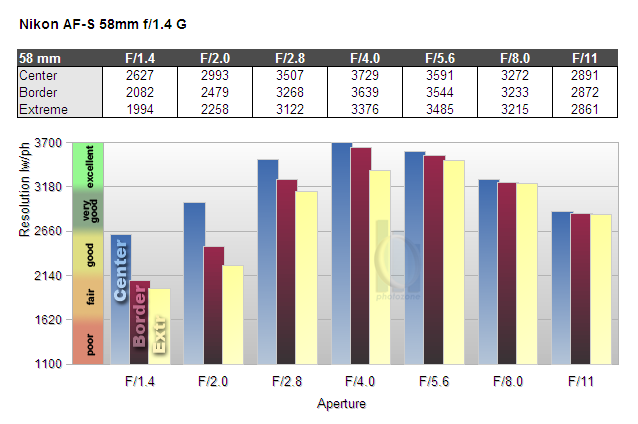|
Nikkor AF-S 58mm f/1.4 G (DX) - Review / Test Report - Analysis |
|
Lens Reviews -
Nikon / Nikkor (APS-C)
|
|
Page 2 of 2

Distortion
On DX, the lens shows a small amount of 0.43% barrel distortion. For the typical subjects shot with this kind of lens, this is basically unnoticeable.

Vignetting
Despite being a very fast lens, the amount of vignetting on the DX sensor is fairly moderate wide open and easily reduced to negligible levels by stopping down. At f/2 already, the amount of light fall-off towards the borders should no longer be an issue.

MTF (resolution)
The lens has two souls when it comes to sharpness. At the largest aperture, the resolution is good in the image center, but just fair at the borders and corners. Stopping down to f/2 improves the situation by 1 step, leading to very good center sharpness with good borders and corners.
At f/2.8, the overall sharpness sees a significant boost. The center and borders are excellent here, with corners just a tad behind. At medium apertures, resolution is outstanding across the whole DX frame.
Please note that the MTF results are not directly comparable across the different systems!
Below is a simplified summary of the formal findings. The chart shows line widths per picture height (LW/PH) which can be taken as a measure for sharpness.
If you want to know more about the MTF50 figures you may check out the corresponding Imatest Explanations

Chromatic Aberrations (CAs)
Chromatic aberrations (color shadows at harsh contrast transitions) are moderate, showing values of 0.73 pixels on average at the image borders wide open, dropping as low as 0.34 pixels at f/4 and slowly increasing again to 0.5 pixels at f/11.

Bokeh
One of the primary usage scenarios for a large aperture lens is to separate the main subject from the background. In such an image the quality of the bokeh (out-of-focus blur) is of major significance.
Out-of-focus highlights have a pretty smooth rendition with minimal outlining at the disc edges. However, even on DX the shape of the highlights shows a deterioration of the disc shape towards "cat's eye". Stopping down helps as usual in this regard. But outlining is a little more pronounced from f/4 onward.
In the critical focus transition zone, the background is fairly smooth whereas the foreground isn't quite as pleasing - however, harsh contrasts are not as smeared as they are on FX.

Bokeh Fringing
Bokeh fringing (non-coinciding focal planes of the various colors) is a common issue with relatively fast glass. As you can notice below the halos have different colors - magenta (red + blue) in front of the focus point and green beyond. Unlike lateral lateral CAs, LoCAs cannot easily be fixed in post processing.
Typical for most fast primes, especially ultra fast ones, the Nikkor shows some amount of bokeh fringing at large aperture settings. The issue is mostly gone from f/5.6 onward.
In addition, these shots also illustrate that there is no focus shift when stopping down.
|
Move the mouse cursor over the f-stop marks below to observe the respective LoCAs
|
| f/1.4 |
f/2 |
f/2.8 |
f/4 |
f/5.6 |
|

|
Sample Shots
You can find some sample images taken with the Nikon D3x in our Nikon FX review of the lens.
Verdict
The Nikkor AF-S 58mm f/1.4 G can undoubtedly deliver impressive results when stopped down, but at large apertures it falls quite a bit short of our high expectations, especially given its very high price tag.
The amount of vignetting is very low for an ultra-fast aperture lens and distortion is nothing to worry about either. Similarly, lateral chromatic aberrations are mostly irrelevant. The quality of the bokeh is good although it doesn't stand out. Especially the foreground blur could be smoother, although that's a lesser issue admittedly.
The build quality is very high thanks to high quality materials and tight tolerances. Some may raise an eyebrow regarding the use of plastic rather than metal for the lens body though. The AF speed is fine without being a benchmark. AF noise is a non-issue thanks to the Silent-Wave motor.
In summary this doesn't sound so bad actually, right ? However, given the price tag, it's worth checking out whether the Nikkor AF-S 50/1.4 G or the Sigma Art 50mm f/1.4 deliver similar results for your personal intended usage at considerably lower costs.
|